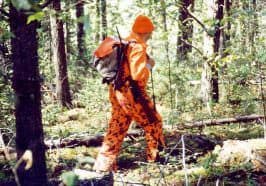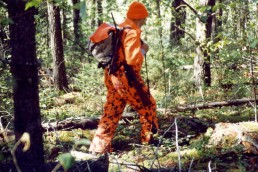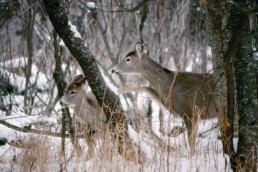Little-known Facts Every Whitetail Hunter Should Know Part four
SHARE THIS POST
Believe it or not, the way you walk in the woods largely determines your success: the number and kinds of deer you will see and take and whether or not your shots will be easy or difficult.
The worst way to walk while hunting whitetails is the way most hunters have been doing it ever since North America’s first European colonists began hunting whitetails: sneaking, often changing direction and halting to listen and scan ahead for deer (mistakenly referred to today as still-hunting). While doing this, most hunters believe their footsteps sound like those of feeding whitetails, enabling them to get close to unsuspecting deer. Sometimes it works, but in most cases the only deer that are fooled are inexperienced fawns and yearlings.

Since 1970, when I first began my hunting-related studies with wild Minnesota deer, I spent a great deal of time attempting to determine the role of human footsteps in whitetail hunting. Within my study area lived two mature does that provided early answers, one with notably black ears and the other with an unusual red scalp. After a few years of regular, year-round camping in or near their home ranges, these two deer no longer reacted with fear each time I approached them. Whether I hiked toward their usual bedding areas from downwind using as much stealth as possible, or if I walked toward them without regard for stealth, they never vacated their beds before we could see one another (10-20 yards apart). If any of my sons tried this, these does always abandoned their beds before they could be seen, making it obvious mature whitetails can distinguish differences in sounds of footsteps made by different humans. Add to such differences some additional sounds characteristic of most human hunters, such as dragging heels and frequently snapping twigs and branches under thick boot soles (7–9 times larger than hoofs of whitetails), and it is highly unlikely any human hunter can actually fool experienced adult whitetails into believing they are merely hearing footsteps of another deer.
Those two does also taught us they could hear footsteps of an approaching hunter 100 to 200 yards away in quiet weather (no winds over 5 mph or precipitation). If you are sneaking, often changing direction and halting to listen and scan ahead, whitetails can still hear what you are doing long before you are near enough to see them. Upon hearing such sounds, experienced mature whitetails know exactly what to do—freeze in cover (standing or lying down if not in a hunter’s path), move stealthily away or flee with great speed (trotting, little sound or bounding noisily) using successful tactics during two or more previous hunting seasons. Whitetails that trot or bound away with their tails up generally temporarily abandon their ranges and/or become nocturnal.
During the first few days of a hunting season, before whitetail range abandonment becomes prevalent, most hunters unknowingly pass within easy shooting distance of eight or more deer per mile traveled on foot. If all deer-tall cover could suddenly be made to vanish during this period, all whitetail hunters would be astonished by the number of them they’d see within a half-mile, with 15 to 30 of them, or 40 percent or more, having antlers.
Though mature whitetails are now skilled at identifying us on the ground or in trees, and fully realize we are dangerous while hunting, they are stuck with us; they can’t simply migrate to safer regions. They therefore have had to learn how to live and flourish where they are despite being in frequent contact with humans. One of the most important things they had to learn is to distinguish “dangerous” hunting humans from non-hunting humans. Like the African antelope that feed complacently within site of non-hunting lions, or the Minnesota whitetails that have learned it is unnecessary to flee upon sighting non-hunting grey wolves, whitetails, where you hunt, will not react with great fear upon identifying nearby humans (via hearing or sight) that are not obviously hunting.
Are you enjoying this post?
You can be among the first to get the latest info on where to go, what to use and how to use it!
The abundant grey wolves of my study/hunting area have long taken advantage of this whitetail adaptation. While scouting for vulnerable prey (deer slowed for various reasons), they march non-stop, single file along favorite paths with heads pointed straight ahead, appearing as if they have nothing in mind except reaching some distant destination. Upon discovering a likely prey, via airborne or trail scents, they don’t halt or begin stalking or pursuing it immediately unless very “neat.” Instead, they continue moving past without pause, keeping their heads pointed straight head until out of sight or hearing downwind or crosswind, thus ensuring that deer will still be in the vicinity when they begin their hunt. While the alpha male or the female attempts to stalk crosswind as near to the selected prey as possible, the rest of the pack circles downwind to wait in ambush. Typically, the deer will discover the stalking wolf before it is too near and will immediately begin fleeing, at which point the wolf will give chase, attempting to driving the deer toward the downwind (undetectable) ambushers. This only works about 20 percent of the time, but generally often enough to provide a pack with fresh venison once per week during winter.
After observing wolves passing unalarmed whitetails, my wife, Jene, and I began using this same ruse to get close to deer in sight to photograph them. After adjusting our cameras, we’d march nonstop along a backwoods road or trail not leading directly toward the deer with our heads pointed straight ahead; we were acting as if we had no idea a deer was near. Upon suddenly halting and snapping our cameras, our first pictures generally featured full-frame, standing, feeding or bedded deer, and our second pictures featured whitetails bounding away with all possible speed—the wolf ruse worked.
What we had learned had extraordinary value in whitetail hunting. If you walk non-stop at a moderate pace along a fairly straight path (predictable to deer), picking up your feet and placing them down lightly while keeping your head pointed straight ahead, you won’t cause ruinous alarm among unseen whitetails along the way. You can improve your odds of seeing some of those deer near your stand site later. If your stand site-approach trail is fairly clean and within 100 yards of your stand (no dead branches to step on), and you bend your knees with each step so you won’t drag your heels even though the feeding whitetails nearby will nonetheless hear the footsteps, they will be far less likely to identify you as something dangerous via hearing. In which, this case they’ll continue feeding but remain extra alert during the next 30 minutes. Once at your site and sitting still and making no discernable movements, those deer will finally decide if whatever they heard was harmless, after which, if they do, they’ll feel free to move in your direction.
If from now on, you hike into the wind or crosswind to well-hidden stand sites downwind or crosswind of where you expected to see deer, and proceed exactly as described above and sit quietly without making easily-spotted motions during the half-day intervals (changing to unused stand sites once or twice daily), you will begin seeing more unsuspecting whitetails (standing, moving) of all classes within easy—or humane—shooting range than you have ever seen after deliberately hunting to and from stand sites or while still-hunting.
Dr. Ken Nordberg has written more than 700 magazine articles and 12 books on the habits and hunting of whitetails and black bears, including the “Whitetail Hunters Almanac” series. He also produced “Doc’s Buck and Bear Hunting School” videos. His encyclopedic website is at drnordbergondeerhunting.com.
MWO
SHARE THIS POST
Did you enjoy this post?
You can be among the first to get the latest info on where to go, what to use and how to use it!



